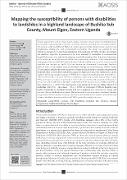| dc.contributor.author | Ssennoga, Martin | |
| dc.contributor.author | Mugagga, Frank | |
| dc.contributor.author | Kisira, Yeeko | |
| dc.contributor.author | Nadhomi, Daniel Luliro | |
| dc.date.accessioned | 2023-03-15T12:47:52Z | |
| dc.date.available | 2023-03-15T12:47:52Z | |
| dc.date.issued | 2022-01 | |
| dc.identifier.citation | Ssennoga, M., Mugagga, F., Nadhomi, D.L. & Kisira, Y., 2022, ‘Mapping the susceptibility of persons with disabilities to landslides in a highland landscape of Bushika Sub County, Mount Elgon, Eastern Uganda’, Jàmbá: Journal of Disaster Risk Studies 14(1), a1266. https://doi.org/10.4102/ jamba.v14i1.1266 | en_US |
| dc.identifier.uri | https://doi.org/10.4102/ jamba.v14i1.1266 | |
| dc.identifier.uri | https://hdl.handle.net/20.500.12504/1257 | |
| dc.description.abstract | Terrain parameters such as slope aspect, angle, curvature, stream power and altitude have
been noted to spur landslide occurrence as well as, acting as a hindrance to evacuation efforts.
Yet, persons with disabilities (PWDs) are seldom given priority during rescue and recovery
programmes during pre- and post-disaster evacuation. The study was guided by two
objectives, namely, (1) to map the landslide risk for households of PWDs and (2) to investigate
the disability type that is perceived to be most affected by landslides. A cross-sectional
household survey was adopted employing snowball sampling, Key Informant Interviews
(KII), and Focus Group Discussions (FGDs) for primary data collection. A 30-m Shuttle Radar
Topography Mission (SRTM) Digital Elevation Model (DEM) was used for terrain spatial
landslide risk analysis in ArcGis 10.8 and System for Automated Geoscientific Analyses
(SAGA) tools. A one-sample t-test in Statistical Package for Social Sciences (SPSS) version
23 was used to analyse the score values on a five-point Likert scale to ascertain the perceived
landslide effect on the different disability categories. Qualitative data was subjected to content
analysis. We found out that majority of PWDs live in high-risk landslide zones with 1400 m –
1700 m, S-E, 10–80, > 10, and –0.8–0.13 of altitude, aspect, slope angle, Stream Power Index
(SPI), and slope curvature, respectively. T-test results revealed that blind and deaf-blind were
perceived as most affected by landslides with t(31) = 58.42, mean = 4.7, p < 0.0001, and t(31) =
34.8, mean 4.6, p < 0.0001. The deaf people were perceived to also be highly affected by
landslides with t(31) = 34.4, mean = 3.9, p < 0.0001. In conclusion, PWDs in Bushika were
highly susceptible to landslide hazards and yet considered as a minority for rescue and
recovery during landslide occurrences. We recommend for prioritisation of inclusive disaster
programmes such as disaster training, relocation, and resettlement to reduce vulnerability and
enhance landslides disaster resilience of PWDs especially in high-risk areas. | en_US |
| dc.language.iso | en | en_US |
| dc.publisher | Jàmbá - Journal of Disaster Risk Studies | en_US |
| dc.subject | susceptibility | en_US |
| dc.subject | Persons with disabilities, | en_US |
| dc.subject | Landslide risk, | en_US |
| dc.subject | Inclusive disaster programmes, | en_US |
| dc.subject | Highland landscape, | en_US |
| dc.title | Mapping the susceptibility of persons with disabilities to landslides in a highland landscape of Bushika Sub County, Mount Elgon, Eastern Uganda | en_US |
| dc.type | Article | en_US |

